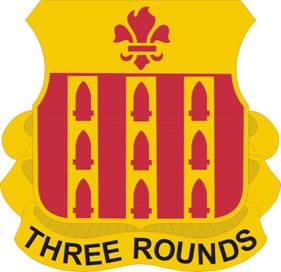333rd Field Artillery Regiment, US Army: Difference between revisions
Knorrepoes (talk | contribs) m (Text replacement - "{{media}}↵" to "") |
Knorrepoes (talk | contribs) m (Text replacement - "{{us}}" to "") |
||
| Line 1: | Line 1: | ||
''' {{uc:{{PAGENAME}}}} ''' | ''' {{uc:{{PAGENAME}}}} ''' | ||
Revision as of 13:11, 27 December 2022
333RD FIELD ARTILLERY REGIMENT, US ARMY
| (Coat of Arms) |
(Distinctive Unit Insignia) |
Official blazon
Shield: Gules, three pallets Or, each charged with a like number of projectiles, palewise of the first, on a chief of the last, a fleur-de-lis of the first.
Crest: On a wreath Or and Gules, a demi-lion rampant Sable armed and langued Azure bearing on the shoulder an escutcheon parti per pale of the second and fourth within a border Argent and grasping a sword-breaker with five barbs Gold.
Motto: THREE ROUNDS.
Distinctive Unit Insignia. Description: A Gold color metal and enamel device 1 1/8 inches (2.86 cm) in height overall consisting of a shield blazoned: Gules, three pallets Or, each charged with a like number of projectiles, palewise of the first, on a chief of the last, a fleur-de-lis of the first. Attached below and to the sides of the shield is a Gold scroll inscribed “THREE ROUNDS” in Black letters.
Origin/meaning
In the scarlet and gold of the Field Artillery, the functions of the organization are illustrated by the stream of projectiles, and even grouping indicates the ability of the Regiment to perform within narrow limits and that the honors of the Regiment mount with each action. The numerical designation is indicated by the three shells on each of three vertical pales; the service in France in World War I being symbolized by the fleur-de-lis. Crest: The lion, from the arms of Belgium, bearing the red and blue shield from the arms of Bastogne, commemorates the action for which Regiment was awarded the Distinguished Unit Citation embroidered “Bastogne.” The white border around the shield represents the encirclement of that city by the enemy and also refers to the snow covered terrain of the “Battle of the Bulge.” The “sword-breaker” was a medieval weapon with barbs or teeth which admitted the sword but prevented its withdrawal. It represents the breaking of the military power of the enemy in Europe. The five barbs stand for the unit’s participation in five European campaigns in World War II.
The coat of arms was originally approved for the 333d Field Artillery Regiment on 28 November 1942. It was redesignated for the 333d Field Artillery Battalion on 9 November 1943. It was redesignated for the 446th Field Artillery Battalion on 13 January 1947. It was redesignated for the 333d Artillery Regiment and amended to delete the Army Reserve crest on 26 May 1960. The insignia was amended to add a crest on 30 March 1966. Effective 1 September 1971, the insignia was redesignated for the 333d Field Artillery Regiment. The distinctive unit insignia was originally approved for the 333d Field Artillery Regiment on 28 November 1942. It was redesignated for the 333d Field Artillery Battalion on 10 November 1943. It was redesignated for the 446th Field Artillery Battalion on 4 March 1947. It was redesignated for the 333d Artillery Regiment on 26 May 1960. Effective 1 September 1971, the insignia was redesignated for the 333d Field Artillery Regiment
Literature: Images from Wikimedia Commons. Information from The Institute of Heraldry, US Army.

